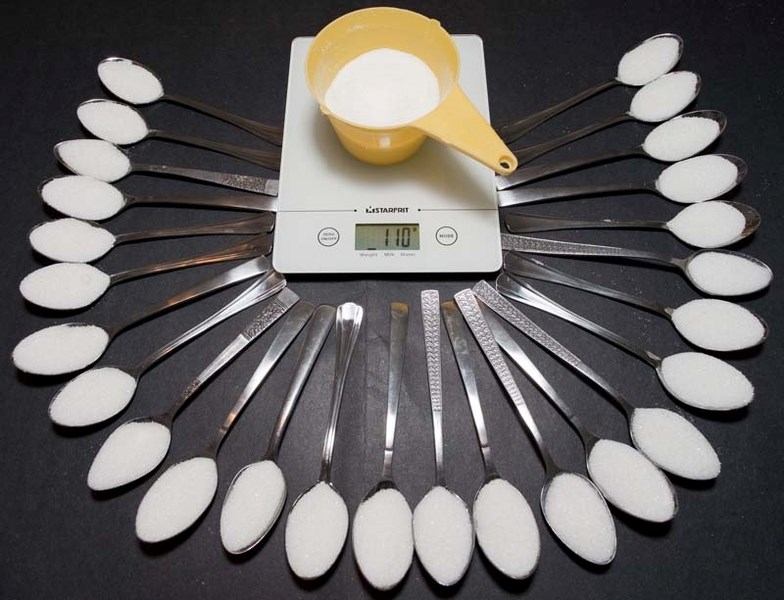Lorne Akins students are getting a sweet surprise this week as they learn about the amount of sugar found in everyday foods.
Food service worker Lisa Buchanan has teamed up with Lorne Akins students this week to hold a series of talks about sugar in food. The talks, based on information from Alberta Health Services, include daily quizzes about sugar (how much sugar is in one bottle of pop?), information about healthy snacks and prizes in the form of passes to Servus Credit Union Place.
Buchanan said she got the idea for the talk last fall after she saw the amount of sugary snacks on sale at the school’s concession (which she helps run).
She was particularly concerned about the bags of penny-candy – 50-cent sacks of 10 jujubes apiece. Some students were buying up to four of them at a time.
Each bag contained the equivalent of eight teaspoons of sugar, Buchanan noted – about 62 per cent of the World Health Organization’s daily recommended dose of added sugar for a 14- to 18-year-old.
“I think sugar is just fine in a diet, but in moderation,” Buchanan said.
But added sugar acts as empty calories, displacing healthier foods that can give you vitamins and proteins as well as energy.
Research by the Canadian Sugar Institute suggests that Canadians already get about 13 per cent of their daily energy from added sugar, she noted – the equivalent of 13.5 teaspoons a day. One 591-millilitre bottle of pop contains 18 teaspoons of sugar.
Buchanan worked with assistant-principal Roger Scott – who is leading a push for healthier food at the school – to put on this week’s series of talks and to limit sales of the penny candy to one day a week (Friday).
Not everyone was sold on the idea, she noted, and she was worried that she’d get a run on candy each Friday after she brought in the change after spring break.
But there wasn’t one, she said.
“One youth said to me, ‘I’m so glad you got rid of the candy bags. Now I’m not tempted.’”
The school has also swapped out the chips and candy bars in its vending machines for healthier fare like granola bars and baked goods, Scott said. They also plan to do theme lunches this fall where the concession will highlight different healthy, tasty foods.
“It’s not just for students. It’s for everyone in the building.”
Buchanan hoped these talks would get students to make healthier choices when it comes to food.
“We’re not taking away choice from students. We’re teaching students about healthy choices.”
Notice a lot of hats on heads today? Maybe it’s because of someone’s mental health.
Students and teachers across Alberta will have their hats on all day Wednesday as part of the annual Hats On! For Mental Health event. The event, organized by the Canadian Mental Health Association and the Alberta Teachers’ Association, happens each May 7.
“The idea is you put a hat on and people will ask why you are wearing a hat,” said Richard Pawsey, a teacher and Hats On co-ordinator at Muriel Martin Elementary.
That gives you an excuse to tell them about the Hats On event and the importance of good mental health.
There’s still a huge stigma about mental illness that keeps people from talking about it, Pawsey said.
Just one in five children who need mental health services in Canada actually get it, reports the Canadian Mental Health Association. Research suggests that the stigma around mental health issues can be a strong deterrent to proper treatment.
Mental health is a lot like physical health, said Pawsey, who plans to wear a propeller beanie as part of Hats On day.
“What are the things we can do to assure that we are in a good mental state?”
Pawsey’s students and other classes across Alberta will spend the day learning about mental health and the importance of eliminating the stigma around it.
Pawsey said his students have spent the last few months learning relaxation techniques, anger management and the importance of a good night’s sleep – all items they can use to manage stress.
Research shows that students who use mental health techniques are more resilient and better able to bounce back from stress, Pawsey said.
“They’re better able to focus on their schoolwork and be successful in school when all that other kind of baggage is dealt with.”
Pawsey hopes teaching kids about mental health now will make them more likely to be open about it in the future.
Visit www.canwetalk.ca for more on the Hats On campaign.




